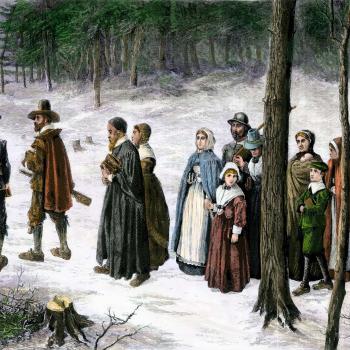Blogger and scholar Adam Laats recently made an fascinating point on his blog, I Love You But You’re Going To Hell.
In her latest “Wrestling with Angels” column, the singer and author Carolyn Arends describes her recent heart-to-heart with her fourteen-year-old son, an ardent young-earth creationist. No way, her son told her, would he ever want to go to the wrong university, where he would have to “sit in some biology class in a secular school and be told I descended from apes.”
Arends was surprised. Though she admits she was a “keen young-earth creationist as a teenager,” she had come to agree that the world had been created through “evolutionary processes.”
…
The second striking point about Arends’ column is its reminder that we Americans can live in parallel universes, where everything looks the same but all the meanings have reversed themselves. I can’t imagine my daughter will ever go through a young-earth creationist “phase.” But if we substitute the phrase “anarcho-syndicalism” or “joys of marijuana” for “young-earth creationism” then I can imagine a very similar scenario to Arends’.
Oh, the memories this brings up. It’s actually very true to my own experience.
I was a young earth creationist before my parents were, strange to say. I had found literature from Answers in Genesis and Henry Morris in my church’s library. I embraced it with a passion. My parents humored me. After attending a homeschool conference where Ken Ham was keynote speaker, my parents became ardent young earth creationists.
This wasn’t the only issue where I went more extreme than my parents. Growing up with the influence of the Christian Patriarchy and Quiverfull movements, of the purity and courtship movements, homeschooled and rotating between AWANA Bible club and services at my family’s evangelical megachurch, I took everything all the way, often even further than my parents did. I’ve written about this before.
[My friends] were all girls like me, raised in similar households with similar beliefs, and we together drove each other more extreme in our quest for holiness. We thought about wearing headcoverings, even though our families didn’t. We liked the idea of having a home church, though our parents never tried it. And more than that, we discussed whether girls should perhaps stay home from college. In fact, even though my parents expected me to go to college and always had, some of my friends almost talked me out of going. I concluded in the end that my friend was right, that girls shouldn’t go to college, but that I still needed to do what my parents expected of me and make the best of it.
And the thing is, I did see myself as a rebel. I was rebelling against mainstream culture, I was rebelling against ungodliness, I was a rebel for God. I sought to go against the flow – wearing skirts and baggy dresses even when it wasn’t popular and refusing to listen to contemporary music. I gloried in being different, in standing out.
What’s interesting is that even the subculture I grew up in has started actively marketing and selling rebellion. In 2008, homeschool leader Greg Harris’ sons founded The Rebolution.
The official definition of the ‘rebelution’ is “a teenage rebellion against low expectations.” When you look around today, our culture does not expect much of us young people. We are not only expected to do very little that is wise or good, but we’re expected to do the opposite. Our media-saturated youth culture is constantly reinforcing lower and lower standards and expectations.
The word ‘rebelution’ is a combination of the words “rebellion” and “revolution.” So it carries a sense of an uprising against social norms. But in this case, it’s not a rebellion against God-established authority, but against the low expectations of our society. It’s a refusal to be defined by our ungodly, rebellious, and apathetic culture. Actually, we like to think of it as rebelling against rebellion.
And it’s exciting, because the Rebelution has become a type of counter-cultural youth movement among young people from around the world, who are not only rejecting the lies of popular youth culture, but they’re returning to biblical and historical levels of character and competence.
We were rebelling, yes – rebelling against rebellion. Reading the Bible was an act of rebellion, going skirts only was an act of rebellion, and I even considered wearing a head covering as an act of rebellion. Remaining under my father’s authority was an act of rebellion, planning to be a homemaker was an act of rebellion, dreaming about naming my numerous future children things like Thankful or Obedience was an act of rebellion.
The odd thing is that I was taught that those “so-called” rebels who dyed their hair and got multiple piercings and tattoos were actually ascribing to conformity in their all-black goth uniforms. (Note: I don’t actually know squat about goth culture or about what public school high schoolers do to rebel.) What I didn’t realize was that if this applied to goth kids, it applied to my race into homeschooled jumpered conformity as well. What I was doing was only different inasmuch as I chose a different subculture with which to align myself in opposition to the mainstream culture.
Whether or not teenage rebellion is some sort of natural or universal biological thing, it is an important part of growing up in our society today, and that goes for both evangelicals and homeschoolers just as for anyone else. And given this, evangelicalism in general and the Christian homeschool subculture in particular have made concrete efforts to harness this rebellion and channel it safely in ways that simultaneously police the edges of the subculture and feed youth’s desire for meaning, purpose, and defiance.
It also bears pointing out that youth rebellion and evangelicalism actually have strong ties historically. While the term “evangelicalism” goes back further, most scholars emphasize the importance of the First Great Awakening (the 1740s) as a founding movement for evangelicalism in America. And the First Great Awakening was made up mostly of youth, and its culturally subversive message concerned many of the more established religious teachers. The same thing happened with the Second Great Awakening (the early 1800s), and once again older and more established religious leaders found themselves on the defensive. Then, during the 1960s and 1970s the Jesus Movement was made up of young people who followed a “hippie Jesus” and defined the religious norms of the time. The Rebolution’s similarities too and differences from these previous movements would be interesting to explore.














